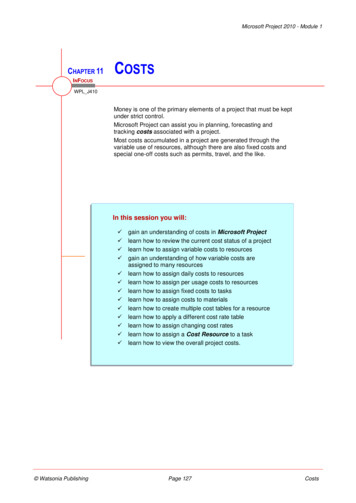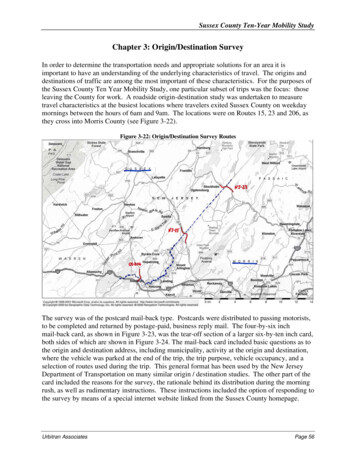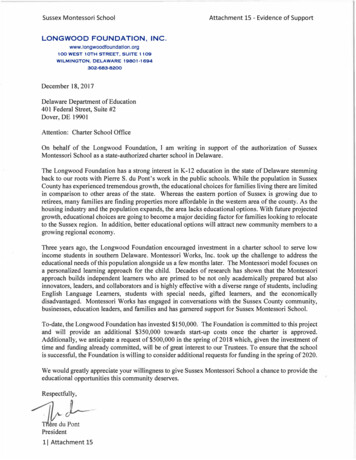
Transcription
Microsoft Project 2010 - Module 1CHAPTER 11COSTSINFOCUSWPL J410Money is one of the primary elements of a project that must be keptunder strict control.Microsoft Project can assist you in planning, forecasting andtracking costs associated with a project.Most costs accumulated in a project are generated through thevariable use of resources, although there are also fixed costs andspecial one-off costs such as permits, travel, and the like.In this session you will: Watsonia Publishinggain an understanding of costs in Microsoft Projectlearn how to review the current cost status of a projectlearn how to assign variable costs to resourcesgain an understanding of how variable costs areassigned to many resourceslearn how to assign daily costs to resourceslearn how to assign per usage costs to resourceslearn how to assign fixed costs to taskslearn how to assign costs to materialslearn how to create multiple cost tables for a resourcelearn how to apply a different cost rate tablelearn how to assign changing cost rateslearn how to assign a Cost Resource to a tasklearn how to view the overall project costs.Page 127Costs
Microsoft Project 2010 - Module 1UNDERSTANDING PROJECT COSTSMicrosoft Project can perform some veryelaborate and sophisticated cost analyses onyour projects. The tools and features in MicrosoftProject will allow you to create an overall projectbudget and to track actual expenses with relativeease. Microsoft Project allows you to createvariable costs, fixed costs and cost-per-usecosts.Variable Resource CostsThe most common type of costing in Microsoft Project is the variable costing assigned to a resource.This is usually the hourly standard and overtime rates for labour, or an hourly standard rate assignedto machinery usage. The way this works in Microsoft Project is a bit like a spreadsheet – you enteran hourly rate into a resource sheet and Microsoft Project will apply that rate to all areas where theresource has been assigned to calculate a total costing for you.A nice feature with variable costs is that you can tell Microsoft Project when to accrue these variablecosts. Variable costs can be accrued at the beginning or end of a task, or prorated as the task isunderway. The table below explains the differences.Accrual TypeUsageBeginningAll costs are accrued at the start of the task. This is used when an up front paymentis required before work commencesProrataCosts are accrued according to the amount of work that has been performed. If 50%of the work is completed then 50% of the costs will be shownEndAll costs are accrued at the end of the task. This is used in situations where youmight be invoiced for the services of a contractor – the invoice is generally raised atthe completion of the work.A slight variation on these variable costs is a per usage cost. Let’s say you need to hire a thing-ame-bob to dig holes. The hire company may charge you on an hourly basis and this would be thevariable costing. However, they may charge you an administration fee each time you hire theequipment. In Microsoft Project you would enter this administration cost into the cost-per-use fieldfor the resource.Fixed CostsMicrosoft Project allows you to assign a fixed cost against a task. For example, you may havenegotiated some contract work at a fixed price for your project. In our case study, Scott Harris, theproject manager, has negotiated for the foundations to be poured by a concrete company. He pays afixed contract price for everything to do with this task – materials, labour, equipment, and the like.The Cost ResourceIn Microsoft Project there is also a cost resource. This may sound a little confusing. Generally,costs are associated with a resource – an hourly rate for labour or a cost-per-use for machinery. Butthere are some costs, such as those associated with travel, or training, or permits, or even a partythat may not be appropriate to link to a particular resource. Microsoft Project provides you with acost resource for these situations – in our case study we have created two of them: one for buildingpermits and the other for our end-of-project party. You ever only enter a cost value for these at thetime they are assigned to a task.Happy, happy, happy Project ManagersWhat is nice about Microsoft Project is that you can mix and match all of these cost elements withinyour project and you can check the status of the costing at any time. You may, for example, havetasks that have variable cost labour, cost-per-use equipment, and some fixed cost contractualcomponents. When you enter all of these elements Microsoft Project will calculate a total cost for thetask and extrapolate that up into the total cost of the summary tasks and then ultimately up into thetotal project level. Watsonia PublishingPage 128Costs
Microsoft Project 2010 - Module 1REVIEWING CURRENT COSTSIn this session you will be working with the costsfor The Rostadium project. The project file youwill open has appropriate calendars and projectsummary information, tasks, durations andmilestones, resources and resource assignments.But it doesn't yet have any cost data. The best wayto check the cost status of a project is to use theProject Statistics dialog box.OpenFileTry This Yourself: Before starting thisexercise you MUST openthe file J410Costs 1.mpp.Click on the Project tabon the Ribbon and clickon Project InformationClick on [Statistics] todisplay the ProjectStatistics dialog boxwhich shows total projectcostsThere probably won’t betoo many costs here justyet! 1Click on [Close]2For Your Reference Handy to Know To display total project costs:1. Click on the Project tab on the Ribbon andclick on Project Information2. Click on [Statistics] to display the ProjectStatistics dialog box It is a good idea to regularly display theProject Statistics dialog box as you entercosts just to ensure things are progressingas they should. Watsonia PublishingPage 129Costs
Microsoft Project 2010 - Module 1ENTERING VARIABLE COSTSIn a project, most of your costs come from theresources that are carrying out the tasks.Typically this will be either labour or machinerywhich is costed on an hourly basis. The costs arecalculated by the duration of the task, or theworking hours of the resource multiplied by theamount entered in the Std Rate and the Ovt Ratein the Resource Sheet.SameFileTry This Yourself: Continue using the previousfile with this exercise, or openthe file J410 Costs 1.mpp.Click on the View tab on theRibbon and click onResource Sheet in theResource Views group3Click on 0.00/hr in Std. Ratefor ArchitectType 160 and presstojump to Ovt. Rate. Type 160and presstwice to jump toAccrue At6Click on the drop arrowthathas appeared and click onEndThe Architect will invoice uswhen his work is done. Click on 0.00/hr in Std. Ratefor DraftspersonType 48000/y and pressjump to Ovt. Rate. Type57000/y and presstocomplete the entrytoClick on the Project tab, clickon Project Information andclick on [Statistics]7Click on [Close]Repeat steps 2 to 6 to enterthe information shown on thefollowing pageFor Your Reference Handy to Know To assign variable costs to resources:1. Display a Resource Sheet view2. Type a variable cost rate in Std. Rate andOvt. Rate Always enter an amount for overtime. Insome cases, such as salaried professionalswho do not get paid overtime, you may beinclined to leave the field blank. If you thenassign overtime, they will be charged at zero.The overtime hours should be charged atcost as an absolute minimum. Watsonia PublishingPage 130Costs
Microsoft Project 2010 - Module 1CASE STUDY VARIABLE COSTSMost larger projects will require you to enter quitea deal of information about the variable costs forthe resources. In our case we have about 30resources, many of which will require variableResource NameBuilding nterLabourerDriverOn The HammerListen Ear AudioIn Focus VideoPure Grass TurfPlumberElectrician Watsonia PublishingStd. .5665.25116.80178.00195.0022.6521.56rates for both Std. and Ovt. to be entered. This ispart of the hard slog associated with setting up aproject. There aren’t any real tricks or traps here soenter the amounts shown below.Ovt. .3497.88116.80178.00195.0033.9832.34Page 131Large amounts, such as 42000,are annual salaries. That is whythey are entered with a /y afterthem to indicate that this is anannual amount. Microsoft Projectwill convert this amount into anhourly basis for calculationpurposes.Note that in order to provide a bitmore “realism” the list ofresources at the left here isn’tthe same as the order ofresources in the project file!Costs
Microsoft Project 2010 - Module 1ASSIGNING DAILY COSTSA number of projects involve the hire ofequipment, which is charged out on a daily basis.You can enter these types of charges intoMicrosoft Project in much the same way as youenter the salaries for labour. To enter a dailycharge for an item simply type the rate followed by/d. When you do this Microsoft Project will stillinternally convert the rate to an hourly rate.OpenFileTry This Yourself: Before starting thisexercise you MUSTopen the file J410Costs 2.mpp.Click on 0.00/hr in Std.Rate for the High JibCraneType 2700/d and pressSince we pay a dailyhire cost there is noneed to enter anovertime amount. If theequipment is used inovertime hours, there isno additional charge tous Repeat steps 1 and 2and add a daily rate forthe following:GraderAir CompressorUtility 2341565/d1280/d215/dClick on the Project tab,click on ProjectInformation and clickon [Statistics]Click on [Close] to closethe dialog box andreturn to the projectFor Your Reference Handy to Know To assign a daily cost:1. Display a Resource Sheet view2. Type the daily cost (/d to make it a daily rate)in Std. Rate for the desired resource3. Repeat step 2 for Ovt. Rate4. Press You should be careful also when it comes toallocating the accrual method. If you have topay for the resource in advance you shouldchange accrual to Beginning. If you pay oninvoice at the end of the usage you shouldchange the accrual to End. In our case studywe will leave accrual as prorata. Watsonia PublishingPage 132Costs
Microsoft Project 2010 - Module 1ASSIGNING PER USAGE COSTSSome resources are charged on a cost-per-usebasis. The Per Use Cost field is used to includea charge that is added once for each unit of aresource that is assigned to any task. Sounds likea mouthful, but the cost per use is a one-time costfor a resource used on a task. It is great for one-offcosts such as a call-out charge for a tradesman orthe flag-fall charge in a taxi.SameFileTry This Yourself: Continue using the previousfile with this exercise, or openthe file J410 Costs 3.mpp.Double click on High JibCrane to display theResource Information dialogboxClick on the Costs tab todisplay the Costs informationIn our case study the hireequipment incurs a daily hirecharge. It also incurs anadditional expense to coverinsurance and administration.This is charged to us on acost-per-use basis. It doesn'tmatter whether we hire theequipment for a day or for ayear we only incur theadditional expense once 35Type 1200 in Per Use Cost,then pressResourcePer Use CostGrader600Air Compressor200Utility67On The Hammer75Click on [OK]Repeat steps 1 to 4 for theresources as shownLet's see what this has done tothe costs. Click on the Project tab, clickon Project Information andclick on [Statistics]Click on [Close]6For Your Reference Handy to Know To assign one time usage costs:1. Double click on the resource, then click onthe Costs tab2. Type the one-time usage cost in Per UseCost3. Click on [OK] You can have the Cost Per Use charge onits own. You can also have it in combinationwith the Std. Rate and Ovt. Rate, as wouldbe the case where a call-out fee and anhourly rate is charged for service calls. Use Resource Usage view to see how andwhere specifically a resource is used. Watsonia PublishingPage 133Costs
Microsoft Project 2010 - Module 1ASSIGNING FIXED COSTSThe Per Use Cost field for resources allows youto assign a fixed usage cost to a resource. Eachtime you use that resource you incur that fixedcost. If you want that cost to occur only once youcan assign a fixed cost to the task rather than theresource. In our case study this is handy forcontract charges, which have been negotiated for aparticular activity or task.SameFileTry This Yourself: Continue using theprevious file with thisexercise, or open the fileJ410 Costs 4.mpp.Click on the View tab onthe Ribbon, click onOther Views in TaskViews, and click onTask Sheet3This sheet doesn’t haveany cost fields so we’llneed to adjust thetable Click on Tables in Dataand click on CostThis table gives you abreak up of costs. We’lluse it for entering fixedcosts for a task 45Click in Fixed Cost forErect fencing, type15900 and pressClick in Fixed Cost forPour foundations, type895000 and pressClick on the Project tab,click on ProjectInformation and clickon [Statistics]Click on [Close]For Your Reference Handy to Know To assign fixed costs for a task:1. Display a Task Sheet view with the Coststable2. Type the appropriate cost into the FixedCost field for the desired task and press You can also set the accrual method in theFixed Cost Accrual field in the Cost tableso that the costs are accrued either at thebeginning or the end of the task. Watsonia PublishingPage 134Costs
Microsoft Project 2010 - Module 1ASSIGNING MATERIAL COSTSIn Microsoft Project, costs for materials areapplied the same way as costs for workresources. You can apply the costs using Std.rates where Microsoft Project will determine thecosts based on the usage. This is ideal forconsumable materials such as nails, timber, fueland the like, and allows you to track expenditure asthe task progresses.SameFileTry This Yourself: Continue using the previousfile with this exercise, oropen the file J410Costs 5.mpp.Click on the View tab on theRibbon and click onResource Sheet inResource ViewsFor all of the materials, theturf, the paint, and the fuel,we wish to be able to trackcosts as the materials areconsumed. By assigning acost per metre to Astro Turf,Project will use this rate andmultiply it by the total numberof metres that we haveindicated will be required inthe assignment of the turf 25These costs are entered as a unit rate in the Std Rate fieldof the resource sheet. Microsoft Project assumes that this isa normal rate and multiplies it by the number of units of thematerial assigned to a task. For example, if you enter 5.00for paint in the resource sheet, and then assign 20 units in atask, Microsoft Project will calculate the cost at 100.00.Click in Std. Rate for AstroTurf, type 65.27 and pressType 8.76 in Std. Rate forPaint and press6Click in Std. Rate for DieselFuel, type 1.89 and pressType 1.76 in Std. Rate forUnleaded Petrol and pressClick on the Project tab, clickon Project Information andclick on [Statistics]Click on [Close]For Your Reference Handy to Know To assign materials costs:1. Display a Resource Sheet view2. Type the cost in the Std. Rate field andpress You can also assign a cost-per-use charge,which effectively allows you to create a fixedcost for the materials. Watsonia PublishingPage 135Costs
Microsoft Project 2010 - Module 1USING ANOTHER COST TABLEMicrosoft Project lets you assign different ratesfor the same resource in the project by creatingadditional cost rate tables for the resource. Thisis useful where a resource may charge differentSameFileTry This Yourself: 1Continue using theprevious file with thisexercise, or open the fileJ410 Costs 6.mpp.Scroll up to and doubleclick on Architect todisplay the ResourceInformation dialog box,then click on the Coststab to see the costings ofthis resourceClick on the B tab to seea different series of costsNow our friends thearchitects normally chargeus an hourly fee. Forspecial jobs however,such as submittingdocumentation (wheretheir proverbials are onthe line) they up the fee(have to pay for thePorsche somehow). rates depending upon the task that they areperforming. Access to these different tables ismade available through the Resource Informationdialog box.4Click in Standard Rateand type 450Click in Overtime Rate ,type 450 and pressClick on [OK] to recordthe changeFor Your Reference Handy to Know To use multiple cost tables:1. Double-click on the desired resource, thenclick on the Costs tab2. Click on the drop arrow for Cost accrual3. Click on the desired table and enter thedesired rates. Click on [OK] You can specify a percentage rate change ina cost rate table from a set date. Once youhave entered the effective date, type in thepercentage change in the Standard Rate,Overtime Rate and Per Use Cost fields, eg. 10% or -7.5%. The actual rate is thencalculated and appears in the field. Watsonia PublishingPage 136Costs
Microsoft Project 2010 - Module 1APPLYING A DIFFERENT COST TABLEMicrosoft Project allows you to specify differentcosts for resources at different times throughoutthe project by using cost rate tables. The defaultCost rate table applied to resources is ‘A’. If youhave more than one cost rate table for a resource,you will need to specify which table is used fordifferent assignments.SameFileTry This Yourself: Continue using theprevious file with thisexercise, or open the fileJ410 Costs 7.mpp.Click on the View tab onthe Ribbon and click onResource Usage inResource ViewsScroll to and click onSubmit plans for approvalunder Architect, click onthe Task tab on theRibbon and click on Scrollto Task45Click on the Format tab onthe Ribbon and click onCost in the Details groupScroll to the right until youcan see the last cost entry– a value will appear therebecause the resource costsare accrued at the end ofan assignmentDouble-click on Submitplans for approval todisplay the AssignmentInformation dialog box andclick on the General tabClick on the drop arrowfor Cost rate table andclick on B7Click on [OK] to use thiscost table in the taskFor Your Reference Handy to Know To apply a different cost table:1. Double click on a task and click on theGeneral tab of the Assignment Informationdialog box2. Click on the drop arrowfor Cost ratetable and click on a different table You can have up to 5 cost rate tables foreach resource and you can create agraduated scale of rates if you use them all. Watsonia PublishingPage 137Costs
Microsoft Project 2010 - Module 1CHANGING RATES DURING A PROJECTMicrosoft Project allows you to enter ratechanges for resources in a project. This is doneby nominating an effective date for the changeand then entering the new rates effective fromthat date. Scott Harris has been in detailednegotiations with the carpenters' union. Thecarpenters have won themselves a 25% pay riseeffective from January 1, 2016.SameFileTry This Yourself: Continue using theprevious file with thisexercise, or open the fileJ410 Costs 8.mpp.Click on the View tab onthe Ribbon and click onResource Sheet inResource ViewsDouble click on Carpenterand click on the Costs tabClick in the Effective Datecell in the second row andcomplete the details asshown3Click on [OK]Now let’s see what impactthis has had on theproject Click on Resource Usagein Resource ViewsClick on Erect wall belowCarpenter, click on theTask tab on the Ribbonand click on Scroll to Task6Scroll right until you cansee JanuaryThe hours should still show45 but the new table willhave kicked in and the costwill be higher7For Your Reference Handy to Know To assign changed rates from a specific date:1. Double click on the desired resource2. Click on the Costs tab3. Click in the next free Effective Date cell andenter the relevant date and rate details It can sometimes be hard to track downchanging rates in a project. If you do have tochange the rates for a resource make a noteof it in the Notes field in the ResourceInformation dialog box. Microsoft Project willdisplay a notes icon next to resources withNotes as a reminder. Watsonia PublishingPage 138Costs
Microsoft Project 2010 - Module 1ASSIGNING COST RESOURCESMicrosoft Project also has a separate costresource which can be a little hard to get yourhead around. This is actually a resource thatappears in the resource pool but doesn’t have acost value until it is assigned to a task. It is great forcosts that aren’t directly influenced by the durationof a task or the usage of other resources. It issimilar to a fixed cost.SameFileTry This Yourself: Continue using theprevious file with thisexercise, or open the fileJ410 Costs 9.mpp.Click on the View tab onthe Ribbon and click onGantt Chart in the TaskViews groupDouble click on Submitplans for approval todisplay the TaskInformation dialog boxand click on theResources tab4Click below Architect,click on the drop arrowand click onBuilding PermitSince this is a costresource there are nounits to worry about,only a cost value toassign Click in Cost, type 2500and pressClick on [OK]Repeat the above stepsand assign the End ofProject Party at a costof 15500 to the OfficialOpening task6For Your Reference Handy to Know To assign cost resources to a task:1. Double click on a task and click on theResources tab2. Choose a cost resource in Resource Nameand enter a cost in the Cost field So why not just enter these amounts asFixed Costs for a task? You can do this, butby creating a Cost Resource you canactually itemise the fixed costs associatedwith a task. For example, if the party and thepermits above were assigned as a fixed costyou’d only see a total amount for the two. Watsonia PublishingPage 139Costs
Microsoft Project 2010 - Module 1VIEWING PROJECT COSTSWhen all of the costs have been entered you canrest assured that there are many ways inMicrosoft Project for you to view those costs. Youcan use the Project Statistics dialog box to seeSameFileTry This Yourself: Click on the Project tabon the Ribbon, click onProject Information andclick on [Statistics] tosee the Project Statisticsdialog boxClick on [Close]Click on the View tab onthe Ribbon, click onOther Views in TaskViews, and click on TaskSheet4Click on Tables in Dataand click on CostClick on Resource Sheetin Resource Views, clickon Tables in Data andclick on CostUsing a resource sheetview you can see the costbreak-down by resource. 1Continue using theprevious file with thisexercise, or open the fileJ410 Costs 10.mpp.Using a task sheet viewyou can see the costbreak-down by task the total project costs. You can use different viewsand tables to see the costs for tasks and also thecosts for resources.5Click on Gantt Chart inTask ViewsFor Your Reference Handy to Know To review project costs:1. Use the Project Statistics dialog box(Project Project Information)2. Display a Task Sheet view with a Cost table3. Display a Resource Sheet view with a Costtable The views can be printed out if you require aquick hard copy summary of the costs. Watsonia PublishingPage 140Costs
Microsoft Project allows you to assign a fixed cost against a task. For example, you may have negotiated some contract work at a fixed price for your project. In our case study, Scott Harris, the project manager, has negotiated for the foundations to be poured by a concrete company. He pays a











